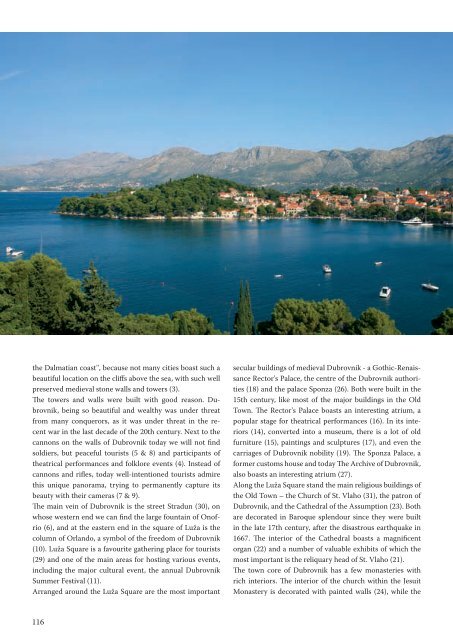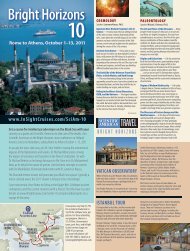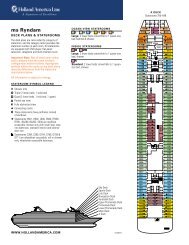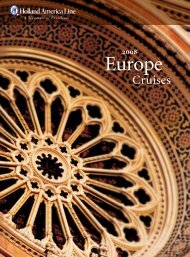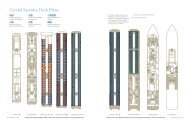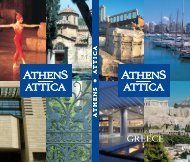Croatian cultural heritage - Business - Hrvatska turistiÄka zajednica
Croatian cultural heritage - Business - Hrvatska turistiÄka zajednica
Croatian cultural heritage - Business - Hrvatska turistiÄka zajednica
You also want an ePaper? Increase the reach of your titles
YUMPU automatically turns print PDFs into web optimized ePapers that Google loves.
the Dalmatian coast'', because not many cities boast such a<br />
beautiful location on the cliffs above the sea, with such well<br />
preserved medieval stone walls and towers (3).<br />
The towers and walls were built with good reason. Dubrovnik,<br />
being so beautiful and wealthy was under threat<br />
from many conquerors, as it was under threat in the recent<br />
war in the last decade of the 20th century. Next to the<br />
cannons on the walls of Dubrovnik today we will not find<br />
soldiers, but peaceful tourists (5 & 8) and participants of<br />
theatrical performances and folklore events (4). Instead of<br />
cannons and rifles, today well-intentioned tourists admire<br />
this unique panorama, trying to permanently capture its<br />
beauty with their cameras (7 & 9).<br />
The main vein of Dubrovnik is the street Stradun (30), on<br />
whose western end we can find the large fountain of Onofrio<br />
(6), and at the eastern end in the square of Luža is the<br />
column of Orlando, a symbol of the freedom of Dubrovnik<br />
(10). Luža Square is a favourite gathering place for tourists<br />
(29) and one of the main areas for hosting various events,<br />
including the major <strong>cultural</strong> event, the annual Dubrovnik<br />
Summer Festival (11).<br />
Arranged around the Luža Square are the most important<br />
secular buildings of medieval Dubrovnik - a Gothic-Renaissance<br />
Rector's Palace, the centre of the Dubrovnik authorities<br />
(18) and the palace Sponza (26). Both were built in the<br />
15th century, like most of the major buildings in the Old<br />
Town. The Rector's Palace boasts an interesting atrium, a<br />
popular stage for theatrical performances (16). In its interiors<br />
(14), converted into a museum, there is a lot of old<br />
furniture (15), paintings and sculptures (17), and even the<br />
carriages of Dubrovnik nobility (19). The Sponza Palace, a<br />
former customs house and today The Archive of Dubrovnik,<br />
also boasts an interesting atrium (27).<br />
Along the Luža Square stand the main religious buildings of<br />
the Old Town – the Church of St. Vlaho (31), the patron of<br />
Dubrovnik, and the Cathedral of the Assumption (23). Both<br />
are decorated in Baroque splendour since they were built<br />
in the late 17th century, after the disastrous earthquake in<br />
1667. The interior of the Cathedral boasts a magnificent<br />
organ (22) and a number of valuable exhibits of which the<br />
most important is the reliquary head of St. Vlaho (21).<br />
The town core of Dubrovnik has a few monasteries with<br />
rich interiors. The interior of the church within the Jesuit<br />
Monastery is decorated with painted walls (24), while the<br />
116


